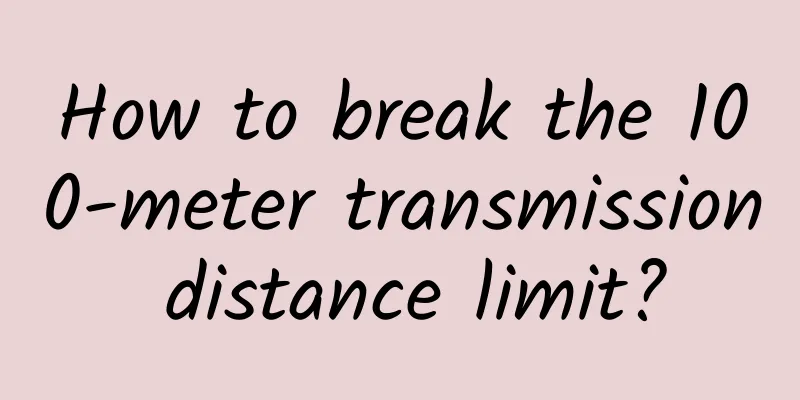How to break the 100-meter transmission distance limit?

|
Local Area Networks (LANs) have historically been designed in a way that ensures all end devices are within 100 meters (m) of the Telecommunications Room (TR) to comply with industry cabling standards. Now, with the adoption of smart building technologies, there are more devices connected to and powered by the network than ever before. Today's LAN environments often encounter situations where connected end devices are too far from the nearest TR to maintain the 100m distance limit. It is well known that twisted pair copper cables are a standards-based option for connecting devices over 100m, but there is confusion in the industry about the distances that twisted pair copper cables can reliably support at various transmission speeds and remote powering levels. In order to strategically address situations where equipment is located beyond 100m and reduce risks, information and communication technology (ICT) professionals need to understand the pros and cons of various options, the technical factors involved, and the key considerations around testing to help them identify the realities and meet the requirements. Options to meet wiring standardsThe ANSI/TIA-568 cabling standards for commercial buildings define the minimum performance requirements for structured cabling to support a variety of applications (e.g., Ethernet, PoE, HDBase-T, DSL, etc.) These industry cabling standards are based on the worst-case minimum performance of cabling system components, links, and channels to ensure an objective, realistic, and measurable basis for interoperability and competition in the marketplace. Therefore, the ANSI/TIA-568 cabling standard has long limited the distance of horizontal twisted-pair copper cabling channels to 100m, including a 90m permanent link and a total length of 10m for patch cords. Maintaining a fixed common horizontal channel length helps extrapolate performance parameters to support increased transmission speeds. With the rise of IoT and smart building initiatives, more devices in more spaces need to be connected to the network than ever before. To cover outdoor spaces, warehouses, parking lots and other remote areas, enterprise facilities or campuses often need to install surveillance cameras, access control devices, wireless access points or other devices more than 100m away from the nearest telecommunications room. To reduce costs and improve efficiency, many of these devices are now also digitally powered via remote powering technologies such as Power over Ethernet (PoE) rather than connected to traditional AC power circuits. Cabling standards-compliant options for connecting and powering devices beyond 100m include adding a new telecommunications room, using decentralized extender devices, connecting devices with fiber optic cables and powering them individually, or using hybrid copper fiber optic cables to carry data and power. Each of these standards-based options has its advantages and disadvantages, as described below: Adding a new telecom room: One option for connecting devices that are more than 100m away is to add another telecom room. This can be a real room, or a mini room housed in a freestanding or wall-mounted cabinet. The benefits of adding another telecom room include compliance with industry cabling standards, centralized management, and the ability to support speeds up to 10 Gbits/sec and deliver up to 90 W of PoE. However, if you only need to support a few remote devices that are more than 100m away, the cost of adding a new TR can be difficult to justify. Not only does a TR take up valuable real estate, but it also requires additional active equipment and the associated power consumption, cooling, and maintenance. Use extender devices: Deploying Ethernet extender devices in the horizontal cable plant is another option for supporting remote devices. Extender devices are much less expensive than adding TRs, utilize existing twisted pair copper cabling, and can support up to 10 Gbits/sec and up to 90 W of PoE, depending on the device. However, extender devices typically require a local power source, which can increase expense. Placing extender devices in the horizontal space also increases remote points of failure and eliminates centralized management, which can make troubleshooting and maintenance more difficult and costly. Connecting devices via fiber: Another option for extending the distance to devices in a LAN is to connect the devices via fiber optic cables. According to TIA standards, an OM3 or OM4 multimode fiber link can support 10 Gbits/sec to a distance of approximately 300m, or 1000 Mbits/sec to a distance of approximately 550m. While fiber is an ideal solution for these longer distances, the cost of fiber optic transmission equipment is difficult to justify for some LAN devices that are only 10 or 20 meters away from the TR. In addition, terminal devices with optical input/output (I/O) ports are limited in the market. Therefore, media converters and copper patch cords are usually required for device connection. PoE media converters have the advantage of providing PoE power to devices, but using optical fiber cables with media conversion functions still requires high optical fiber transmission equipment costs. Use Hybrid Copper Fiber Cable: Even if a device does include a fiber port for connecting it directly to a fiber network and does not require a media converter, if a local power source is not available, the device will need to obtain available power through some means other than PoE. One option is to use hybrid copper fiber cable, which includes optical fibers for data transmission and copper conductors for power transmission. Using hybrid copper fiber cable still requires more expensive fiber transmission equipment, as well as a Class 2 Limited Power Source (LPS) to provide power. It is important to note that Class 2 power provided over hybrid copper fiber cable is not PoE. Although PoE is a Class 2 power source, it is only supported by twisted pair copper cables. When using hybrid copper fiber cable, it is important to carefully select the size of the copper conductor, which is typically up to 12 AWG. The gauge of the copper directly affects how much power can be delivered over a specific length. Additionally, using Class 2 non-PoE power sources over hybrid copper fiber cable requires careful planning and voltage drop calculations to ensure that there is enough power to support the device based on its current draw and distance from the power source. After deployment, if the conductor size is too small or the distance is too far to support the power requirements of the end device, the only options are to replace the cable, add additional copper conductors, or reduce the link length. This can severely hinder moves, adds, and changes, as well as the ability to use hybrid copper fiber cable for future devices. A more cost-effective approachWhile not compliant with ANSI/TIA-568 cabling standards, the most cost-effective option for connecting devices beyond 100m is to simply extend the distance of the twisted pair copper cable connection. This approach requires no additional space, equipment, or points of failure. Regardless of the length, twisted pair copper cabling also supports familiar modular RJ45 connections and installation practices – other than pulling the cable 90m away from the TR, the installation process for longer links is no different than any other twisted pair copper cable. Using twisted pair copper cabling also supports centralized management for easier troubleshooting and maintenance, and enables efficient remote powering via PoE directly from a PoE-enabled switch. When comparing the various options for connecting equipment beyond 100m from the TR, it is clear that twisted pair copper cable is the most attractive from a cost perspective, as shown in the following table: Although not compliant with standards, twisted pair copper cables are the most cost-effective option for extending distances beyond 100 meters. Technical factors involvedAlthough twisted pair copper cabling is the most cost-effective option for extending horizontal cabling distances beyond 100m, there are several factors that must be considered. Since the ANSI/TIA-568 cabling standard does not currently support extending twisted pair copper cabling channels beyond 10m, it is necessary to review the application standards. Cabling standards define minimum performance requirements for structured cabling links, channels, and components to support applications typically up to 100 m, with the goal of ensuring interoperability between components from different manufacturers. Certification testing to cabling standards is performed at the time of installation, which is often a requirement for scope of work and to obtain a warranty. Cable standards testing is performed on cables that are not yet actively supporting applications, connected to equipment, or transmitting data. In theory, a cable that complies with a cabling standard should ensure support for any application designed to be used with that specific type of cable, up to 100 meters. In contrast, application standards look at the ability of a specific application to operate on a link segment, regardless of cabling components and distance. Key performance parametersLength-dependent performance parameters such as insertion loss, propagation delay, DC resistance, and signal-to-noise ratio (SNR) are closely related to the ability of a link segment to support a specific application at a specific length. Insertion loss – Measured in decibels (dB), insertion loss is the amount of energy a signal loses as it travels through a cable. If the loss is too high, the signal may not be strong enough to be properly received or interpreted by a connected active device. The greater the distance the signal must travel, the greater the insertion loss. Connection points in a link add to the overall insertion loss. Insertion loss also increases with frequency and temperature. This is why the maximum allowable insertion loss for each cabling standard is specified to be higher for Category 6A at 500 MHz (42.8 dB) than for Category 6 at 250 MHz (31.1 dB), Category 5e at 100 MHz (21.0 dB), etc. Propagation Delay – In four-pair applications, propagation delay, the amount of time it takes to receive a signal at the far end of the link, increases with length and can vary from one pair to another. Measured in nanoseconds (ns), if the difference between the pair with the least delay and the pair with the most delay, called delay skew, is too large, it can cause bit errors, preventing proper data transmission. In video surveillance applications, excessive propagation delay is often seen as a jittery display. Too large a difference between the pair with the smallest propagation delay and the pair with the largest propagation delay can prevent proper data transmission.
Key influencing factorsInsertion loss, DC resistance, propagation delay skew, and SNR affect the distance that twisted pair copper cable can support for a given application, and these factors are affected by several factors - from speed and PoE level to cable construction and quality, as well as various design and installation variables. All of these factors are why there is currently no industry cabling standard for extending twisted pair copper cable distances beyond 100m.
What is the reality?There are several IP-based network devices that operate at lower speeds (1000 Mbits/sec or less) and require lower levels of PoE power. Devices such as surveillance cameras, phone booths, access control panels, PoE lighting, time clock systems, intercom/paging systems, energy management systems, and environmental sensors and controls are examples of low-speed, low-power devices that typically need to be located more than 100m away. For example, it may be necessary to install a surveillance camera outside a warehouse, an access control panel at the far end of a factory, or an emergency call box in a parking lot. At lower speeds and lower PoE power levels, performance factors such as insertion loss and voltage drop are less likely to affect distance capabilities. Additionally, most reputable manufacturers design twisted pair copper cabling systems to exceed cabling standards and provide greater margins, including improved insertion loss, propagation delay, and DC resistance. While this helps ensure support for 100m applications regardless of installation variables and environmental factors, it also allows several reputable manufacturers to certify certain twisted pair copper cables to support a variety of low-speed, low-power applications at distances exceeding 100m, and many of these advanced cables are even advertised as providing longer distances for specific applications. Unfortunately, while many high-quality twisted-pair copper cabling systems can support lengths in excess of 100m, there is still much confusion in the industry about the distances they can reliably support at various transmission speeds and remote powering levels. Much of this confusion stems from some manufacturers’ claims of being able to support extended distances for high-speed, high-power applications, but based on inadequate methodologies to test and validate performance at various lengths. The reality is that supporting Type 3 (60 W) and Type 4 (90 W) PoE transmission speeds of 10 Gbits/sec and higher for extended distances is extremely challenging, even for reputable and innovative manufacturers. Applications that require these higher speeds and PoE levels, such as emerging high-throughput WiFi 6/6E deployments, When considering using twisted pair copper cabling to extend distances beyond 100m, it is important to carefully understand the claims by verifying the manufacturer's cable specifications, understanding the testing requirements, identifying the risks and asking the right questions. Understand the testing requirementsWhen selecting twisted pair copper cable for distances over 100m, it is important to review the manufacturer specifications and understand how the cable is tested. Reputable manufacturers test their cabling systems to meet the minimum performance requirements of the cabling component standards. This ensures that any application designed to run up to 100m on that specific cable type (i.e. Category 5e, Category 6, Category 6A, etc.) will be supported. Installers then field test the cable plant against the cabling standards to ensure that the installed links also meet the performance and distance requirements to support the applications designed to run on the specific cables. However, compliance with the cabling standards does not indicate whether these cables will support applications beyond 100m. This is where application testing comes in. Reputable cabling manufacturers perform rigorous lab testing and third-party distance verification based on IEEE application standards (i.e. Ethernet, PoE, etc.) and various conditions (such as topology, ambient temperature, and end-device requirements). They also perform lab bit error rate (BER) testing using specific device network interface cards (NICs). BER testing sends actual Ethernet packets in both directions at a specific speed to check for errors. It is through this comprehensive testing methodology that many reputable manufacturers are able to guarantee twisted pair copper cables for specific applications and distances in excess of 100m. Cabling standards define the minimum performance requirements for structured cabling to support applications over 100m, while application standards look at the ability of a specific application to operate on a link segment regardless of cabling components and distance. BER testing is done with specific equipment under specific conditions, which is more suitable for engineering solutions. Application testing can also be performed in the field and is recommended for twisted pair copper cables with channel lengths greater than 100m. Application testing reduces risk by ensuring that the application is supported at a specific distance. BER testing can also be performed in the field, but unlike application testing, it evaluates a specific device at a specific distance and under specific conditions. In other words, BER testing is more suitable for evaluating engineering solutions and may fail if any variables (including equipment, temperature, external noise and other factors) change. Recognize the risks of variationFor anyone considering using twisted pair copper cabling to connect devices over 100m, it is important to understand that each device is unique. Equipment manufacturers design switch ports and devices to meet the minimum requirements for successful transmission within the application link segment limitations, which can be easily achieved with 100m of cable. However, each device may vary in its ability to adapt to transmission irregularities associated with extended distances. This means that a link that successfully connects two specific devices over long distances may not function if one of the devices changes. This is true even when using devices from the same vendor, but of different types. The variability that occurs in long-distance links introduces uncertainty, which is why application testing is so important—either in the lab, by the cable manufacturer, or in the field. If only BER testing is performed, performance cannot be guaranteed as equipment is replaced and conditions change, eliminating future-proofing. Ask the right questionsGiven the various variables that affect distance capabilities and the various marketing claims in the industry, it is important to ask the right questions when selecting twisted pair copper cables for long-distance deployments. This is especially true with vendors who claim their cables can support higher transmission speeds and PoE levels at distances that seem too good to be true and/or far beyond the specifications of trusted, reputable manufacturers. For example, adhering to the following guidelines can significantly reduce risk:
SummarizeNot too long ago, we saw cabling standards being established, and now, the industry can’t function without them. While industry standards currently don’t address long-reach deployments due to a variety of variables, there is light at the end of the tunnel—we are seeing a trend toward long-reach standards that will help eliminate confusion in the market and prevent manufacturers from making marketing claims that are not backed up by testing. Collaborative efforts among some cable manufacturers, standards bodies, and distributors have helped establish validated measurement methods to guarantee results and protect the design intent of extended range for standards-based installations. The new Single Pair Ethernet (SPE) standard, which supports low-speed devices at 10 Mbit/sec to 1000 meters with PoE up to 13.6 W, may also eventually address the need to connect greater distances between sensors, actuators, relays, and controllers used in building automation systems and some security deployments. To achieve this, equipment vendors need to integrate SPE technology into their chipsets. In the meantime, anyone looking to extend the distance of twisted-pair copper cable beyond 100m should talk to their cable manufacturer and ask the right questions to verify performance before investing. If marketing claims seem far-fetched, look for a reputable cable manufacturer who stands by empirical evidence and guarantees their cables for applications and power levels up to realistic distances. Consider that even twisted-pair copper cabling from the best-known and most innovative manufacturers is typically unable to support speeds of 1000 Mbits/sec or higher at up to 90W Type 4 PoE for much more than 100 m due to physics. For lower-speed 100-Mbit/sec applications that include multiple device types, distances may be much higher than 100 m, especially at lower PoE levels. For many lower-speed devices, it is risk-free and very cost-effective to extend distances beyond 100 m using twisted-pair copper cabling from well-known manufacturers. Ultimately, however, anyone looking to select a twisted-pair copper cabling system for distances greater than 100 m should do their own due diligence. |
<<: Let you understand the MQTT protocol
>>: Cyber Security Awareness Week丨Ruishu Information explains how to ensure data security?
Recommend
Zhaorong Tribe wishes you a happy new year! Good luck in the Year of the Tiger!
On the occasion of the Chinese New Year, the trib...
Qualcomm demonstrates 5G new air interface connection based on 3GPP for the first time, which is expected to become a global standard
At the "2017 Qualcomm 5G Summit" held r...
RAKsmart cluster server 5+253IP monthly payment starts from $189, and you can choose data centers in Los Angeles/San Jose/Japan/Hong Kong, China, etc.
RAKsmart is a foreign hosting company operated by...
What is the difference between unmanaged and managed industrial network switches?
There are two basic types of industrial network s...
Akamai Li Wentao: Starting from four major strategies, helping enterprises build a new paradigm for public cloud
In today's digital age, cloud computing has b...
Talk about RocketMQ master-slave replication
RocketMQ master-slave replication is one of Rocke...
Cisco pledges to be carbon neutral by 2040
In response to calls to limit global warming to 1...
Do you know which city has the fastest Wi-Fi speed in the world?
Since the coronavirus crisis, fast internet has b...
Summary information: CUBECLOUD/Duoxiantong/CYUN/PIGYun/Ouluyun/VoLLcloud/Hongsu Technology
July and August are the summer vacations, and man...
Ministry of Industry and Information Technology: In the first four months, my country's telecommunications business revenue totaled 486.2 billion yuan, a year-on-year increase of 6.6%
[[400860]] According to the latest data released ...
How do operators’ mountaineering teams climb “5G+Industrial Internet”?
Industry is the foundation of a country and the m...
SDN, the new decade, rethinking: the transformation has shown its edge, and the dawn of intelligence is beginning to emerge
Technological innovation remains the most appropr...
10gbiz: Hong Kong/Los Angeles CN2 GIA line VPS 40% off $2.36/month, Hong Kong/Japan dedicated server 15% off first month starting at $27.43
10gbiz released a September discount plan, provid...
The three major operators collectively experienced a "late spring cold" in February: 4G business performance was poor and broadband market growth was weak
Perhaps it was because the performance in January...
Keda joins hands with Ningxia Public Security Bureau to deepen the reform of "delegating power, deregulating and serving the people".
On November 27, the National Public Security Orga...









